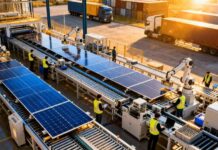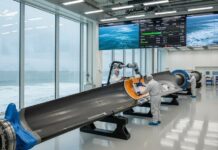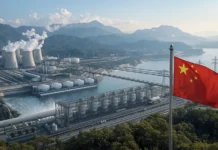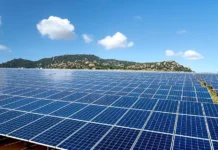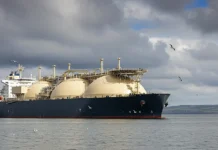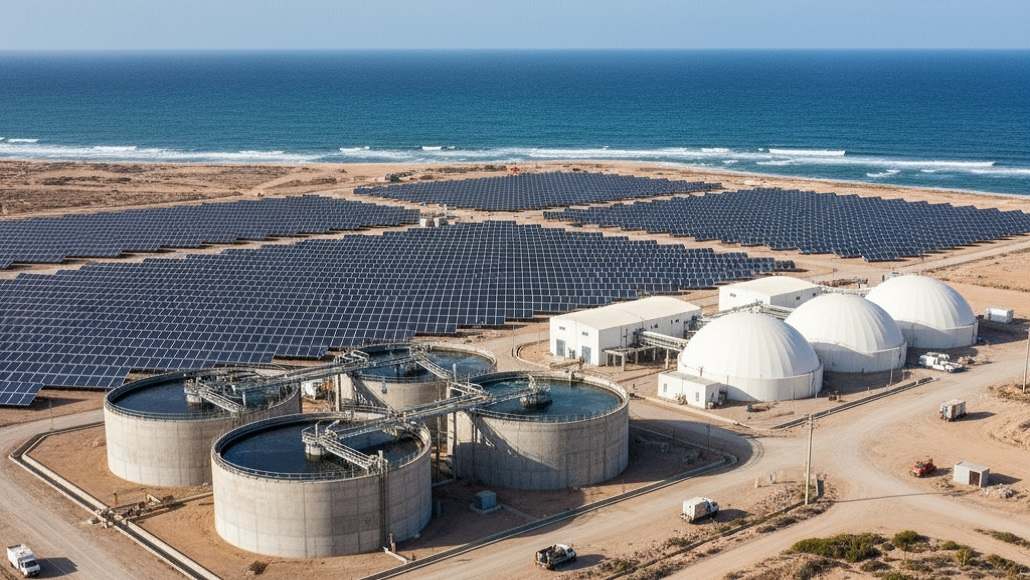Solar Desalination: Powering Water Security through Clean Energy
Water scarcity ranks among humanity’s most pressing challenges, affecting billions of people across water-stressed regions worldwide. As climate change intensifies drought conditions and population growth strains finite freshwater resources, solar desalination has emerged as a transformative solution that addresses both water security and energy sustainability simultaneously. By harnessing abundant solar energy to convert seawater and brackish groundwater into potable water, this technology offers hope to communities facing existential water crises while advancing clean energy deployment.
The Global Water Crisis and Renewable Solutions
The Middle East and North Africa region stands at the epicenter of global water scarcity, classified as the most water-scarce region on Earth with renewable water resources below 500 cubic meters per person annually. Traditional water sources including rivers, lakes, and aquifers are rapidly depleting, while climate change exacerbates the situation through altered precipitation patterns, increased evaporation rates, and more frequent droughts. Conventional desalination technologies, while providing essential water supplies, consume enormous quantities of energy derived primarily from fossil fuels, creating a tension between water security and climate commitments.
Solar desalination technologies resolve this dilemma by powering the water purification process with renewable solar energy. The region’s abundant solar potential, which also drives renewable energy transitions, becomes doubly valuable when deployed for both electricity generation and water production. This convergence of the water-energy nexus through solar-powered solutions represents a critical pathway for addressing anticipated water scarcity challenges while meeting sustainability objectives.
Direct Solar Desalination Technologies
Solar stills represent the simplest and oldest form of solar desalination, mimicking Earth’s natural water cycle through solar-heated evaporation and condensation. These passive systems trap solar energy to heat saline water, causing evaporation that leaves salts and contaminants behind. Water vapor rises and condenses on cool surfaces, dripping into collection containers as purified water. The process replicates how nature makes rain, removing impurities including salts, heavy metals, and microbiological organisms to produce water cleaner than the purest rainwater.
Direct solar desalination works exceptionally well for water purification but produces relatively modest daily volumes due to low operating temperatures. Typical daily freshwater output per square meter ranges from 2 to 3 liters depending on solar still design, solar intensity, and weather conditions. This output level proves ideal for small-scale family needs in remote areas where the average person requires approximately two liters of water daily for survival.
Recent innovations have dramatically improved solar still performance. The integration of Fresnel lenses to concentrate solar energy can boost daily yield and thermal efficiency by 467 percent and 84.7 percent respectively, increasing output from 1.62 to 9.22 liters per square meter. Multi-stage configurations enabling condensation heat recovery further enhance efficiency, with some advanced designs achieving over 1.5 gallons of drinking water per hour for every square meter of sunlight.
The Massachusetts Institute of Technology developed a groundbreaking four-stage solar distiller system that combines film-wise evaporation, short mass transfer distances, and enlarged condensation surfaces to maximize productivity. These technical innovations demonstrate how century-old principles can be revitalized through modern engineering to address contemporary water challenges.
Photovoltaic-Powered Reverse Osmosis Systems
Photovoltaic electrodialysis represents perhaps the most transformative advance in solar desalination, combining proven reverse osmosis technology with direct solar power integration. MIT engineers built a desalination system that runs exclusively on photovoltaic power and promptly reacts to subtle changes in solar radiation to maximize energy generation. The solar-powered system removes salt from water at a pace that closely follows changes in solar energy, automatically adjusting to variations in sunlight by dialing down in response to passing clouds or revving up as skies clear.
This system requires no extra batteries for energy storage nor supplemental power supply from the grid, distinguishing it from other solar-driven desalination designs. Engineers tested a community-scale prototype on groundwater wells in New Mexico over six months, working in variable weather conditions and water types. The system harnessed on average over 94 percent of electrical energy generated from solar panels to produce up to 5,000 liters of water per day despite large swings in weather and available sunlight.
The technology maximizes solar energy utility by continually varying power consumption in sync with the sun, directly and efficiently using solar power to make water without requiring battery storage. This breakthrough addresses a massive grand challenge: making drinking water with renewables without battery storage, which conventional desalination technologies require to smooth out variable power sources.
Photovoltaic electrodialysis offers higher water recovery rates, easier operation, longer membrane lifetime, and improved operation at high temperatures compared to traditional reverse osmosis techniques. The system consists of solar panels, maximum power point tracking, batch tanks, parallel pumps, an electrodialysis stack, and reversal valves. In the stack, ions transfer across selectively charged membranes including pairs of cation exchange and anion exchange membranes. The system continuously increases flow rate and applied current density until their combined power matches available solar power.
Concentrated Solar Power Integration
Concentrated solar power technologies enable truly 100 percent solar desalination by providing dispatchable energy through thermal energy storage. While photovoltaic systems deliver lowest cost per watt, they lack cheap large-capacity storage and produce variable output throughout the day. Desalination plants cannot be turned off when clouds pass, as stopping operations causes salt crystallization that forms crusts on membranes, leading to scaling problems that damage equipment.
When photovoltaic-powered plants lose sunlight, they must switch to grid power, resulting in less than fully solar operation. The same issue applies to concentrated solar power without storage. However, concentrated solar power with thermal energy storage can deliver very flat power profiles throughout day and night, providing the dispatchability essential for continuous desalination operations.
Storing energy proves expensive, but storing water in normal tanks costs very little. When electricity demand is low, desalination modules can operate to produce extra freshwater for storage, maximizing both energy asset utilization and water production efficiency. This operational flexibility improves the financial case by keeping reverse osmosis plants working maximum hours, reducing the impact of capital investment costs on final water prices.
The recently announced Metito plant in Saudi Arabia demonstrates concentrated solar power integration for reliable desalination. While some facilities claim solar power while switching to grid electricity at night, true solar desalination systems use thermal storage to maintain operations around the clock without fossil fuel backup.
Applications Addressing Regional Water Security
The Middle East has embraced solar desalination as strategic infrastructure for water security. The Dubai Electricity and Water Authority contracted with Desolenator for one of the first major solar-thermal desalination plants in the region. The plant operates around the clock independent of the electricity grid, using thermal batteries charged during daylight and discharged at night. Lithium-ion batteries provide backup during power outages, ensuring continuous operation.
Desolenator’s technology reduces carbon emissions by 1,400 percent compared to reverse osmosis by separating salt from water through evaporation, producing low-concentration non-toxic brine or achieving zero liquid discharge by producing salt. This salt can be mined using nano-filtration to obtain valuable minerals including calcium, magnesium, sodium, chloride, and even lithium. The company signed a second contract with Silal in Abu Dhabi for agricultural irrigation water, with Silal calling the technology a paradigm shift in handling the vital water-food-energy nexus.
The United Arab Emirates provided Cyprus with portable desalination units producing up to 15,000 cubic meters daily to address emergency water shortages following a major plant outage. These units strengthen water resilience during peak demand periods, demonstrating how solar desalination can provide rapid-deployment solutions for acute water crises.
Saudi Arabia invested 533 million dollars in Riyadh water and sewerage infrastructure to improve water systems in alignment with Vision 2030 goals. The project emphasizes sustainable urban development where solar-powered desalination plays an increasingly central role. With Vision 2030 targeting 50 percent renewable electricity by 2030, the Kingdom is well-positioned to power desalination with clean energy.
Kenya provides a powerful example of solar desalination impact in developing regions. GivePower’s Kenya-based solar desalination plant began pumping 2,000 gallons of clean water for 35,000 people every day in 2020. This installation demonstrated how solar desalination can transform water access in coastal communities lacking reliable electricity infrastructure, providing life-sustaining water at affordable costs.
Economic Viability and Cost Structures
Solar desalination economics have improved dramatically as photovoltaic panel prices declined and system efficiencies increased. A community with expensive trucked water costing 6 dollars per cubic meter can implement an Elemental Water Source producing 5 cubic meters per day off-grid using only solar energy, achieving 75 percent savings on water expenses and total savings exceeding 300,000 dollars. The solution’s payback averages around 2.5 years depending on several factors
Beyond financial savings, solar desalination eliminates dependency on water trucking and associated carbon emissions, saving 10 tonnes of carbon dioxide per year while providing high-quality potable water on-site. The technology leads to community empowerment, job creation, and educational opportunities that extend benefits far beyond water provision alone.
MIT researchers developed a cost-effective solar-powered desalination device that could provide a family with potable drinking water for as little as 4 dollars. This dramatic cost reduction makes solar desalination accessible to communities previously unable to afford conventional desalination or even trucked water. The assessment of various solar still designs revealed the most economical option using double-slope, single-basin with flat plate collector would cost 7.8 dollars per cubic meter for small systems.
Larger systems achieve substantial economies of scale. Industrial and municipal installations producing thousands of cubic meters daily can achieve water costs competitive with conventional desalination while eliminating fossil fuel consumption and associated emissions. The elimination of electricity costs from grid-connected desalination represents a major operational expense reduction that improves long-term financial viability.
Environmental Benefits and Sustainability
Solar desalination delivers profound environmental benefits beyond emissions avoidance. By eliminating fossil fuel combustion for desalination operations, these systems prevent air pollution that affects local communities near conventional plants. The reduction or elimination of greenhouse gas emissions contributes directly to climate change mitigation, creating a virtuous cycle where addressing water scarcity simultaneously advances climate objectives.
Advanced solar desalination systems minimize brine discharge environmental impacts. Conventional desalination produces highly concentrated brine that, when returned to oceans or disposed improperly, can harm marine ecosystems. Desolenator’s low-concentration brine or zero liquid discharge approach eliminates this environmental concern while enabling mineral recovery that creates additional economic value.
The integration of solar energy with water production exemplifies circular economy principles, where one renewable resource enables access to another essential resource without depleting either. This sustainable approach contrasts sharply with fossil fuel-powered desalination that consumes non-renewable energy to access renewable water resources.
Decentralized solar desalination reduces the need for extensive water transportation infrastructure including pipelines, pumping stations, and distribution networks that consume energy and resources. Communities can produce water locally where needed, reducing water losses from evaporation and leaks that plague long-distance water transport systems.
Integration with Agricultural and Industrial Applications
Solar desalination extends beyond drinking water provision to enable agricultural productivity in water-scarce regions. The Silal contract in Abu Dhabi specifically targets agricultural irrigation water, recognizing that food security depends fundamentally on water availability. Solar-powered desalination for agriculture allows crop production in coastal areas previously unsuitable for farming, potentially transforming food production landscapes in arid regions.
Industrial applications including manufacturing, mining, and energy production require substantial water quantities often unavailable in resource-constrained regions. Solar desalination provides industries with reliable water supplies independent of municipal systems or vulnerable groundwater aquifers. This water security enables economic development while reducing pressure on limited freshwater resources that communities depend upon for drinking and sanitation.
The coupling of solar desalination with aquaculture presents particularly promising opportunities. Coastal communities can use solar energy to desalinate seawater for fish farming operations that provide protein to growing populations. The integration creates self-sufficient food and water production systems powered entirely by renewable energy.
Technology Advancement and Innovation Pathways
Research and development continues advancing solar desalination performance and reducing costs. Hybrid solar desalination systems combining multiple technologies demonstrate superior structure and performance compared to single-technology approaches. By incorporating waste heat energy into the desalination process, these systems reduce expenses while enhancing overall effectiveness. The utilization of waste heat energy holds great promise for improving efficiency and sustainability of hybrid solar desalination systems.
Membrane technology improvements including enhanced permselectivity, fouling resistance, and longevity directly improve photovoltaic electrodialysis economics. Research into selective membranes that discriminate more effectively between anions and cations can increase water recovery rates while reducing energy consumption per unit of purified water produced.
Thermal storage innovations enabling longer-duration operation from solar energy collected during daylight hours will improve concentrated solar power desalination viability. Advanced phase-change materials, molten salt systems, and other storage mediums under development promise to extend solar desalination operations through extended cloudy periods or overnight, reducing reliance on backup power sources.
Artificial intelligence and machine learning applications can optimize solar desalination operations by predicting solar availability, adjusting flow rates and pressures in real-time, and scheduling maintenance during optimal windows. These digital technologies enhance overall system performance while reducing operational complexity for plant operators.
The Path to Universal Water Security
Solar desalination represents more than a technological solution to water scarcity. It embodies the convergence of renewable energy deployment with fundamental human needs, demonstrating how clean energy transitions can simultaneously address multiple sustainable development challenges. As photovoltaic costs continue declining and system efficiencies improve, solar desalination will become increasingly accessible to communities most affected by water insecurity.
The Middle East’s leadership in deploying solar desalination at scale, driven by both acute water needs and abundant solar resources, provides models that other water-stressed regions can adapt. The lessons learned, technologies developed, and operational experience gained in the region will benefit implementations globally as water scarcity intensifies with climate change and population growth.
Achieving universal water security through solar desalination requires sustained investment in research and development, supportive policy frameworks that prioritize renewable-powered water infrastructure, and international cooperation that shares knowledge and technology across borders. The integration of solar energy and water security creates resilient communities capable of thriving despite climate challenges, exemplifying how thoughtful technology deployment can transform existential threats into manageable challenges on the pathway to sustainable development.



